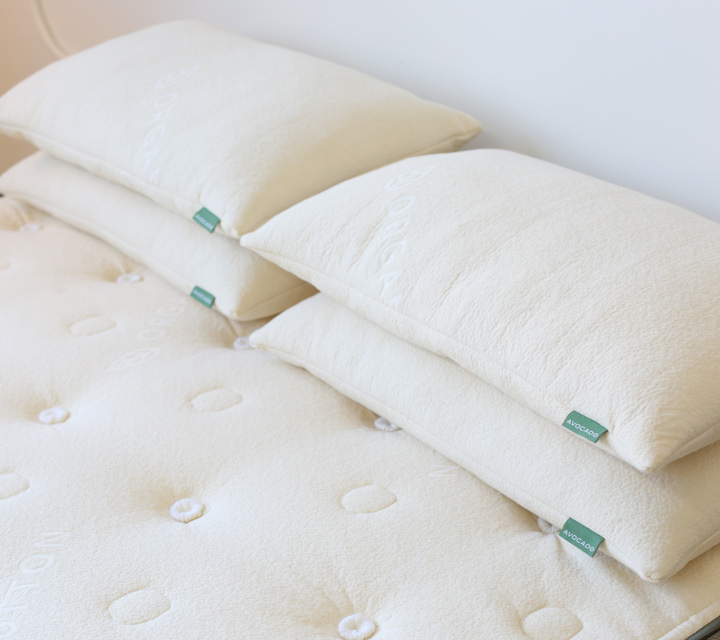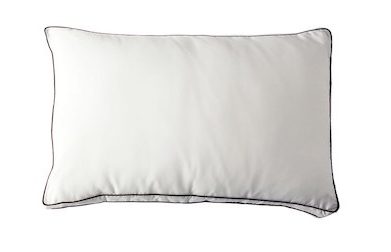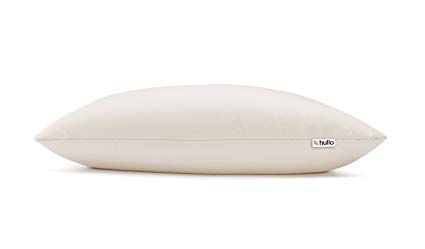Buying Guide – How to Shop for an Organic Pillow
Organic pillows are popular among today’s sleepers for several reasons. Because they are made from natural materials such as latex, wool, and/or cotton, they tend to be exceptionally durable and resistant to wear-and-tear. Organic pillows also sleep cooler due to the natural breathability and temperature neutrality of their components.
Responsible production is another strong point. In order to be considered organic, companies must abide by strict international guidelines for manufacturing processes, carbon emissions, and the use of pesticides and herbicides. Additionally, organic pillows containing animal-related materials (such as wool) must be produced using cruelty-free means.
This buying guide will discuss requirements for organic pillows, common materials used to construct them, and some key factors first-time shoppers should take into account.
What Is an Organic Pillow?
By definition, an organic pillow must receive certifications from the GOTS, GOLS, or other certifying bodies. Pillows containing these components that have not earned the certifications should be considered “natural,” not organic. Many pillow brands advertise their products as “organic,” even though they have not earned the proper certifications.
Materials that may be found in an organic pillow include the following:
Natural/Organic Latex
Latex is a rubber-like substance derived from the sap of rubber trees. Once extracted, latex is processed using either the Dunlop or Talalay method to yield a foam that is resilient, breathable, and responsive. Many sleepers find latex more supportive than memory foam, which tends to sink more.
Some pillows contain synthetic latex, which is primarily made of petrochemicals. The latex may also be blended, meaning it contains a mix of natural and synthetic latex. According to the GOLS, latex must be at least 95 percent natural to be considered “organic.” However, it’s important to note that latex is never 100 percent organic because some chemicals are needed to produce latex foam.
The term “natural latex” is not regulated to the same extent as organic latex. Generally, natural latex contains up to 30 percent petrochemicals and at least 70 percent natural sap.
Organic Cotton
Cotton is a natural fiber that may be grown organically, meaning it has not been genetically modified and is grown without chemical pesticides, herbicides, or fertilizers.
The U.S. Department of Agriculture’s National Organic Program (NOP) oversees organic cotton certifications nationwide. According to the NOP, any product seeking certification must consist of at least 95 percent organic materials.
Other organizations oversee organic cotton certification at the international level. In order to receive the GOTS certification, a pillow must contain at least 70 percent organic materials. The remaining 30 percent is also subject to certain material restrictions, such as polyfoam and formaldehyde. The GOTs also covers “the processing, manufacturing, packaging, labelling, trading and distribution” of organic textiles.
The Textile Exchange is another international organization. This entity awards the Organic 100 Content Standard (OE 100) to products made entirely from organic materials, and the Organic Blended Content Standard (OE Blended) to products containing some organic components.
Natural/Organic Wool
Wool is commonly used as a pillow fill because it is very soft, but also fairly supportive. The material is also highly breathable, and can wick away moisture from the sleeper’s body.
Natural wool must be sheared from sheep, lambs, or goats. In order to be considered organic, the USDA lists the following conditions:
- The wool may not be genetically engineered in any way.
- Beginning in the third trimester of gestation, each individual animal must receive organic-certified food, foraging/pasture, and bedding.
- At least 30 percent of the animal’s diet must consist of dry matter consumed while grazing in an outdoor pasture environment.
- Synthetic hormones and medicines are mostly prohibited. For approved synthetic medicines, livestock owners must first attempt to treat their animals using disease prevention methods. Furthermore, any pasture where animals graze cannot be treated with chemical pesticides, herbicides, or fertilizers.
For wool producers seeking an organic certification, the USDA also prohibits the practice of dipping, which involves bathing sheep in pesticides to rid them of pests. Mulesing, or the removal of skin around the animal’s hindquarters to prevent flystrike, is also prohibited.
The GOTS oversees certification of organic wool at the international level. A product containing wool must be at least 70 percent organic to receive this certification.
Down and Feathers
Some pillows contain down, the soft inner plumage found on ducks and geese. The material is very soft and lightweight. Although some pills contain only down, most supplement the down with coarser outer feathers from the same birds.
In recent years, down and feather producers have come under fire for certain practices that are considered cruel. This includes the removal of down and feathers from live birds, which may also be known as “live-plucking” or “molt-harvesting,” as well as force-feeding and unsanitary living conditions.
The Responsible Down Standard was created to protect ducks and geese from these practices. Brands selling 100 percent down products can seek this certification, which involves an onsite audit of all farm and slaughterhouse facilities.
The Federal Trade Commission (FTC) also regulates how down and feather products are sold. According to the FTC, a pillow or other product listed as “100 percent down” or “pure down” cannot contain any feather fill. For products with a mix of down and feathers, an accurate ratio – such as 70 percent down, 30 percent feathers – must be listed when selling the product.
Other Pillow Materials
In addition to latex, cotton, wool, and down/feathers, the following materials may be found in organic and natural pillows:
- Buckwheat Hulls: Buckwheat hulls are the hard exterior casings around buckwheat kernels. As a pillow fill, the hulls provide a very firm surface with resilient support. Organic buckwheat pillows must be made from hulls grown and harvested without chemical agents. Most buckwheat pillows have organic cotton covers, as well.
- Kapok Fibers: Fibers from the kapok tree have a light, feathery consistency that makes the material a good substitute for goose or duck down.
- Silk: Silk is a fibrous material produced by the silkworm for building cocoons. When processed into a fabric, silk is exceptionally soft and lightweight. For pillows, silk is normally used as a cover material.
Lastly, it’s important to note that some materials should never be considered natural or organic, despite marketing claims to the contrary. For example, memory foam is a purely synthetic material. Although some brands tout “eco-friendly” or “green” memory foam, it is almost always made entirely from chemicals and other synthetic components.
Another material to question is “bamboo fabric,” also known as rayon from bamboo. The material is relatively eco-friendly because bamboo does not require chemical fertilizers or pesticides. However, the fabric is technically a synthetic because chemical processes are used during production.
Additional Certifications
When looking for a new pillow, shoppers may notice other green certifications for materials and manufacturing processes. These certifications do not necessarily mean the pillow is organic, or even all-natural, but eco-conscious buyers can use them to compare different models. These certifications include:
- OEKO-TEX Standard 100: The International Association for Research and Testing in the Field of Textile and Leather Ecology (also known as OEKO-TEX) awards this certification. It is granted to companies that meet acceptable emission levels for volatile organic compounds (VOCs), formaldehyde, and other substances that are harmful to humans. OEKO-TEX also awards the OEKO-TEX Made in Green certification to companies that use sustainable manufacturing processes.
- CertiPUR-US: This certification is most commonly associated with polyfoam and memory foam products. It tests for harmful substances in foam, such as lead and polybrominated diphenyl ethers (PBDEs), as well as harmful emission levels. CertiPUR-US is considered a top certification for products with polyfoam because this material is completely synthetic, making it ineligible for GOTS certification.
- Eco-Institut: Eco-Institut is headquartered in Germany. The organization tests mattresses, pillows, and other bedding materials for harmful substances and emission levels.
- GreenGuard: GreenGuard tests mattresses and other bedding products for levels of VOC off-gassing. The standard GreenGuard certification indicates acceptable off-gassing levels, while the GreenGuard Gold certification is awarded for products that produce little to no off-gassing.
- Cradle to Cradle: This organization evaluates organic materials based on how sustainably they are produced. Specific criteria include carbon emissions, water conservation, and ecological footprint.
- Global Recycled Standard: In addition to the Organic Content Standard, Textile Exchange also provides this certification for products that contain recycled, sustainably produced components.
This list of certifications is not exhaustive. Consumers should take note of all certifications listed for a pillow model, then research each one to ensure they are trustworthy, unbiased, and independent.
Organic Pillow Performance Ratings
The term “organic pillow” is fairly broad, since a pillow with this distinction can contain a wide range of different materials. The table below lists some construction details, pricing information, and pros and cons for four of the most common natural/organic pillow types.




